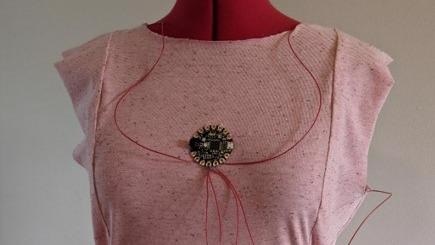Jun 30 2021
According to computer scientists at the University of Bath, garment seams sewn with conductive yarn can be utilized to monitor body motion precisely when placed strategically.
 A garment sewn with conductive yarn, with seams connected by wire to a microcontroller. Image Credit: Olivia Ruston.
A garment sewn with conductive yarn, with seams connected by wire to a microcontroller. Image Credit: Olivia Ruston.
Above all, these charged seams can respond to delicate movements that cannot be picked up by well-known fitness trackers, like wristbands and watches.
As part of new research, scientists from Bath discovered that clothing made with conductive seams can be examined to determine the movements of the wearer.
There are lots of potential applications for conductive yarn in any activity where you want to identify and improve the quality of a person’s movement. This could be very helpful in physiotherapy, rehabilitation, and sports performance.
Olivia Ruston, PhD Student, University of Bath
Ruston presented the study at the ACM Designing Interactive Systems conference in June 2021.
For a certain period, various research groups have been involved in making flexible, textile sensors for garments, but the project executed in Bath is considered to be the first where scientists have experimented with the concentration and location of conductive seams.
The researchers discovered that where seams are positioned on a garment and the number of seams added, are crucial factors in the design of a movement-tracking smart garment.
There’s great potential to exploit the wearing of clothing and tech – a lot of people are experimenting with e-textiles, but we don’t have a coherent understanding between technologists and fashion designers, and we need to link these groups up so we can come up with the best ideas for embedding tech into clothing.
Olivia Ruston, PhD Student, University of Bath
The yarn utilized by Ms. Ruston and her group includes a conductive core that is a hybrid metal-polymer resistive material used mainly for pressure and stretch sensing. As soon as the yarn is integrated into a garment’s seam, it is triggered at low voltages. The resistance oscillates as body movement modifies the tension over the seams.
In the study, the seams were linked to a microcontroller as well as a computer, where the voltage signal was recorded.
Our work provides implications for sensing-driven clothing design. As opportunities for novel clothing functionality emerge, we believe intelligent seam placement will play a key role in influencing design and manufacturing processes. Ultimately, this could influence what is considered fashionable.
Mike Fraser, Study Co-Author and Professor, Head of Computer Science, University of Bath
More than it Seams: Garment Stitching in Wearable e-Textiles
Video Credit: University of Bath.
Journal Reference:
Ruston, O., et al. (2021) More than it Seams: Garment Stitching in Wearable e-Textiles. Association for Computing Machinery. doi.org/10.1145/3461778.3462103.
Source: https://www.bath.ac.uk/